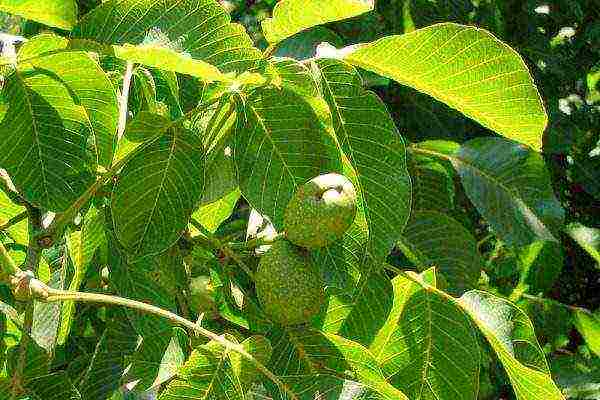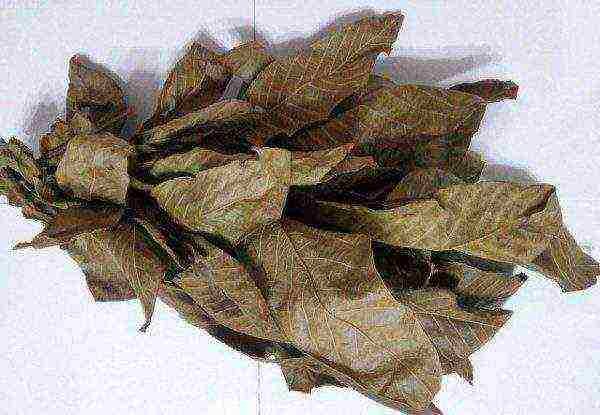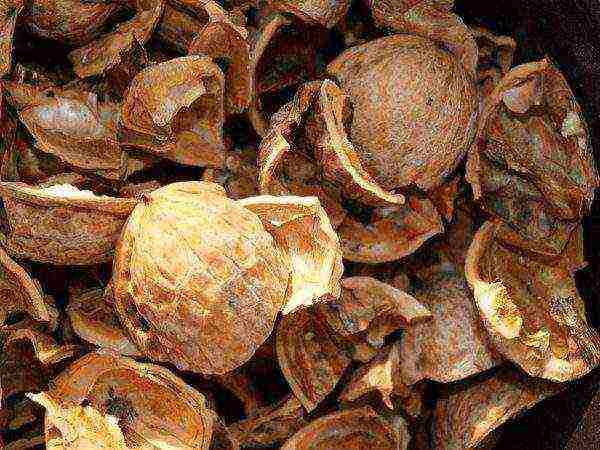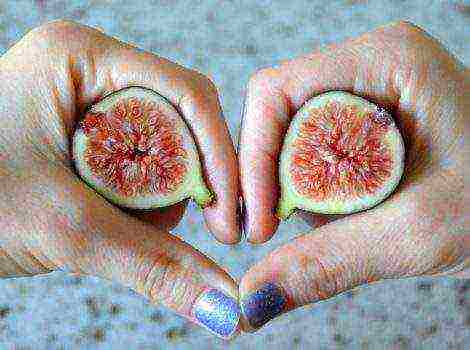Content
Useful properties and contraindications of walnut leaves
A tree up to 25 meters high with a spreading crown and gray bark. The aroma around the tree is very peculiar, and the leaves, large, with the next placement - this is a walnut... Everyone knows about the benefits of its seed for the brain, but few people have an idea that other parts of the plant have both useful and medicinal properties and contraindications.
Composition, useful properties and contraindications of nut leaves and shells
In folk medicine, walnut leaves and pericarps have been used for a long time. Green leaves contain such vitaminsas ascorbic acid and carotene, as well as PP, E and a small amount of B1, which is simply necessary to strengthen the nervous system. They are also in the shell.

The amount of ascorbic acid increases with the growth of the leaf until the middle of the vegetative period, i.e. until about the end of July. At this time, its content reaches 600-1300 mg. It helps to strengthen the walls of blood vessels, support the functioning of the kidneys and liver... They are also valued for their high carotene content - up to 30 mg per 100 grams of the product, which improves vision, stimulates immunity and is a strong antioxidant. They also contain a large amount of minerals such as potassium and magnesium, zinc and manganese, phosphorus and iodine, which is valuable in many places.
Flavonoids, essential oils, organic acids, aldehydes and other substances also have a positive effect on our body, healing it as a whole and curing many diseases. Found in the leaves and a special substance with an antitumor effect - juglone.
According to its unique composition, walnut shells can safely claim the palm in terms of medicinal properties. Indeed, it has a fairly high content of ascorbic acid and vitamin E, which are involved in maintaining hormonal levels and improve immunity.
How to collect and dry walnut leaves
In order for the medicinal raw material to have the most beneficial effect, it must be properly prepared. You need to collect leaves in late May or early June.when they have not yet finally reached their size. It is then that they contain the maximum amount of necessary and useful substances.
You only need to rip 3-5 extreme leaves on a branch, and before drying, the petioles of each leaf blade are also cut off. For drying, they are laid out in a thin layer in direct sunlight. In the process, it is necessary to periodically turn it over, making sure that blackness does not appear. Its appearance testifies to the loss of healing properties of the raw material.

The harvested leaves are stored for two years. Better keep them in a cloth bag, but in glass they also remain well.
The healing properties of the leaves
The area of application of the leaves of this tree is wide. What kind of effects are not exerted by biologically active substances contained in the leaves - anti-inflammatory and vasoconstrictor, tonic and strengthening, diuretic and choleretic, bactericidal and appetite-inducing. In addition, the high potassium content has a beneficial effect on the work of the heart.And for the treatment of diabetes mellitus, there is no better medicine than walnut leaves. It is recommended to use the leaves in the following cases:
- with diseases blood (anemia);
- for recuperation after a long illness or severe physical stress;
- to increase the resistance of the human body to various colds and viral diseases;
- inflammatory processes (lymph nodes, pyelonephritis, cystitis, furunculosis, with damage to the skin);
- for prevention oncological diseases (in the presence of neoplasms in the female breast);
- gynecological problems (uterine bleeding, leucorrhoea);
- in violation hormonal background (including menstrual irregularities in women);
- diseases urinary system (urolithiasis, kidney and bladder disease);
- joint diseases (rheumatism, gout);
- lung diseases (tuberculosis, hemoptysis);
- anthelmintic the effect;
- various skin diseases (urticaria, cutaneous tuberculosis, acne, eczema, various types of lichen, eczema, and wet as well). The most effective in this case is a bath, which is prepared as follows - a pound of leaves is boiled in a liter of water for ten minutes, then infused until it cools, filtered and poured into water with warm water. Take no more than 20 minutes;
- at inflammatory processes in the middle ear, 3 drops of juice from fresh leaves will help.
Recipes and benefits of teas and nut leaf infusions
Naturally, each of the problems listed above requires a special approach to treatment. And the recipe for different diseases is different. Indeed, in one case, internal use is required, and in the other, external.

- So, in violation of menstruation in women, a decoction is better. It is extremely simple to prepare.One and a half tablespoons of dry, crushed walnut leaves are poured with half a liter of boiling water and infused for about two hours. Strain and squeeze out plant materials. The resulting liquid take three times a day before meals for 30 gram... By the way, this infusion also has a slight diuretic effect.
- To relieve pain during menstruation for women, tea made from walnut leaves will help. To do this, you just need to pour a tablespoon of dry crushed leaves with boiling water and let it brew for ten minutes. A fragrant and healthy drink is ready. It is recommended to drink it three times per dayas usual tea and the effect will not keep you waiting. It is recommended to drink tea and people suffering from diabetes.
- For the treatment of inflammatory processes in the oral cavity or throat it is better to use a decoction for gargling. To prepare it, pour two tablespoons of chopped walnut leaves with a glass of water and put on the fire. Bring to a boil and wait another minute, then remove from heat, let stand for another hour and then strain. This broth is also suitable for douching., with inflammatory processes in women.
Walnut shell application
The shells of nuts, which we usually just throw away, are collected by knowledgeable people and treated with it for many diseases. So, for cleansing blood vessels from cholesterol plaques, as well as for strengthening the walls, a tincture prepared in the following way will greatly help.

Grind a shell of 14 nuts and fill with a bottle of vodka. You need to insist within a week in a place inaccessible to sunlight. Then strain and take one tablespoon on an empty stomach in the morning. It also helps with various cysts, tumors and acts as an expectorant, with blockage of the bronchi, mastopathy, thyroid diseases. For those suffering from hypertension, this remedy is also irreplaceable.
A decoction from this part of the walnut is indispensable for women's health. Cervical erosion and inflammation can be cured using the following recipe... Grind the shell of twenty nuts and add to an enamel bowl, pour half a liter of water and keep on fire until the water acquires the color of strong tea. Strain the resulting solution and dilute with boiled water in proportion 1:10... Douch.
The ash obtained from the shell is used to treat skin ulcers, cleanse the gastrointestinal tract from radiation. It also helps with ingestion and incontinence.
Walnut shell recipes in cosmetology
Modern cosmetics very often contain shells in their composition, because in a crushed state it is simply indispensable for removing dead skin cells and excess fat. Here are some recipes for making face and skin cream.
- For making shell peeling you need two tablespoons of shells crushed in a coffee grinder, half a glass of thick sour cream, two tablespoons of black radish and 3 tablespoons of a decoction of chamomile medicinal. Mix all these ingredients and refrigerate for five minutes. Apply the finished cream to the skin and leave for 10 minutes. You can use this tool no more than twice a month.
- Our great-grandmothers also used ash from the shell to remove unwanted hair... To do this, they simply mixed it with a small amount of water and the resulting slurry was applied to the desired area. And no irritations, allergic reactions!

- Back in the Middle Ages, the Armenian doctor Amirdovlat Amasiatsi recommended mixing red wine, olive oil and shell ash. If you apply the resulting mass to the hair, then it will grow faster.look healthy.
Conclusion
Not only the walnut kernel is useful for our body, but also other parts of the plant - leaves, shells, bark, etc. After all, they contain a large amount of minerals, vitamins, organic acids, tannins and many others. They have a great influence on our body, including a therapeutic one. There are no organs and systems in our body that are not influenced by the nut. It is for this reason that it is considered simply irreplaceable for health.


